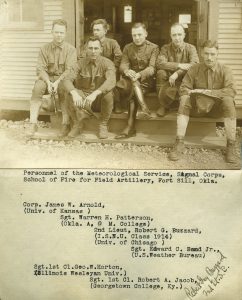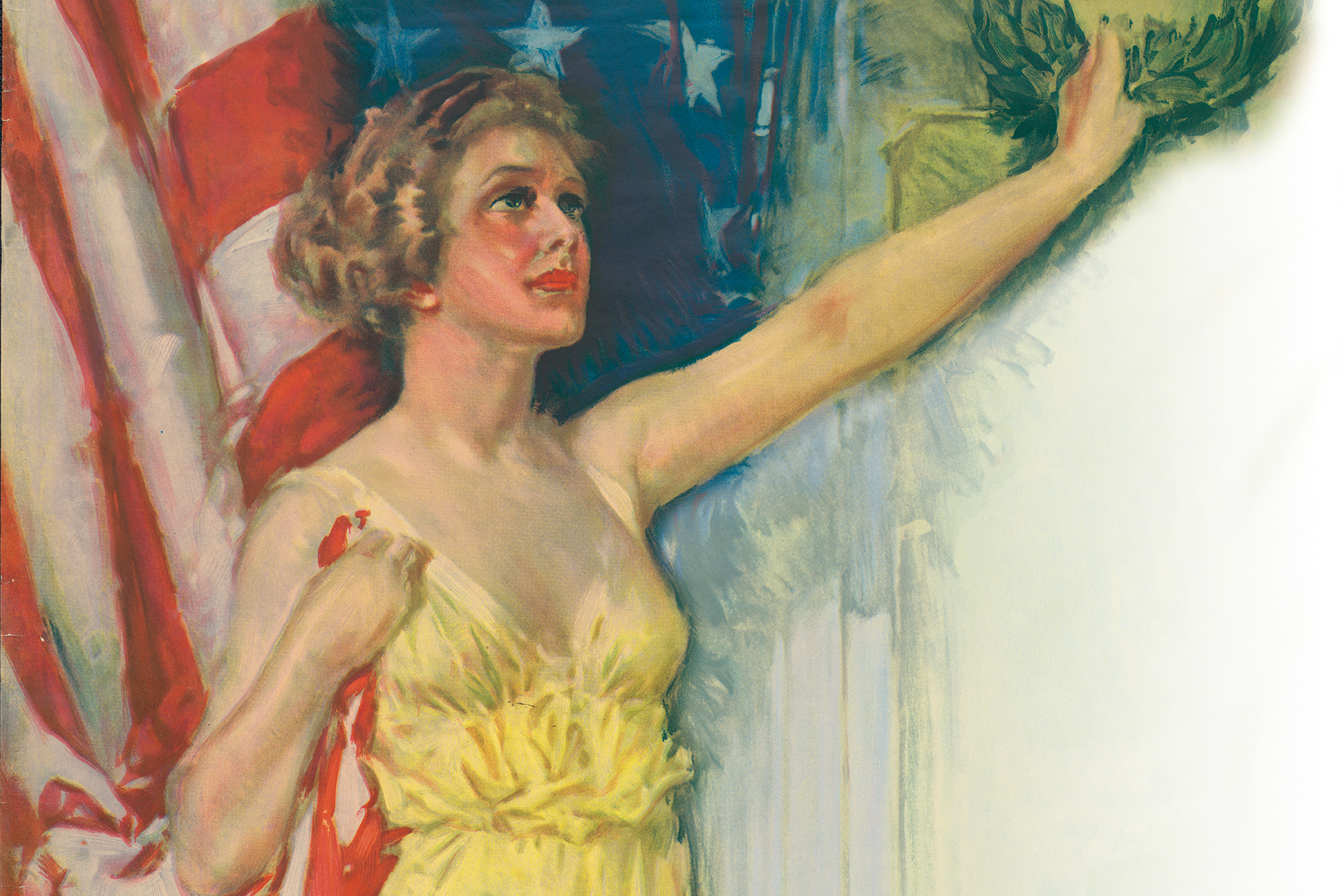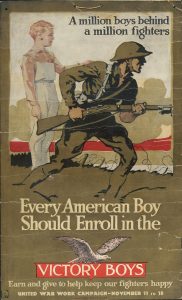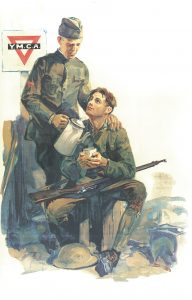The mood at Illinois State this fall as students complete the academic routine of another semester is far more serene than what the University community experienced a century ago. In 1917, the nation had been drawn into World War I. For many students and faculty, that meant an interruption in learning and teaching as duty called.
Just as the campus rallied during the Civil War with creation of the Schoolmaster’s Regiment, patriotism rose at the University and across Illinois when the United States joined forces with the Allied countries to defeat the European Central Powers.
The Office of the Adjutant General shows that 351,153 men from the state joined the armed forces. Of that number, 5,000 lost their lives fighting for international freedom. Fourteen of those men were affiliated with the University. They are forever honored on a bronze tablet placed near Fell Hall that includes each man’s name and the phrase “For our tomorrow, they gave their today.”
Appears InThe impact on campus was significant, as revealed through the efforts of Ange. V. Milner, for whom Illinois State’s Milner Library is named. She had a prescient sense of the historical importance of World War I. As the University’s first librarian, she felt a duty to preserve for posterity the involvement of the campus in the global conflict.
Others at the University partnered with her in the effort. President David Felmley appointed faculty to a War Service Committee. Members documented active duty service men, who were students, staff, faculty, or alumni of either the University or its Laboratory School—University High School.
Milner built the roster using a broad definition of service. She included not only those with a military role but also individuals who contributed as nurses and volunteers with relief agencies such as the Red Cross, YMCA or Salvation Army.
She asked individuals to complete a survey that detailed their experiences, including branch of service, where they had served and dates of time spent at each location. Milner verified each respondent’s connection to Illinois State and documented from their completed form if they were drafted or enlisted, if they had been wounded, and any medals received for their service.
The roster, which contains biographical details of each person, grew to include records of 806 individuals. There are 685 remaining today. It has been deemed by the Illinois State Historical Library as one of the most complete in the state.
“She was saving this for the future,” Angela Bonnell said of ISU’s WWI collection. Bonnell is the University’s government documents librarian. “She wanted the University to have this.”
Milner’s commitment to preserving WWI materials tied to ISU and the nation as a whole resulted in a historical treasure trove that expanded far beyond a list of individuals. She maintained correspondence with many of the people she contacted, writing approximately 600 personal letters during the war years to those serving.
The connections to home and Illinois State came through clearly in the letters she received in return, with frequent mentions of friends, faculty, and even The Vidette. The letters also gave an intimate sense of what the men were experiencing.
John Feek enlisted in the Army in January of 1918. In November of that year, he wrote Milner from “somewhere on the Atlantic.” He confessed feeling “quite unnerved as we left the U.S., for to me it was the embarking of a great adventure.”
“All are anxious for the voyage to be over and the destination reached. No one knows just where it is to be, but why wonder. All will be new and strange and enveloped by a cover of uncertainty,” Feek shared. “I wish I could write more of the events, before and after leaving, but it would be most unwise to do so. However, I shall have many, many tales to tell when it is all over.”
Milner’s records show that Feek served in France through 1919. He died from tuberculosis in 1923 at the age of 32. There are newspaper clippings about Feek in ISU’s collection, as Milner gathered articles from papers at the local and national level.
She also preserved 108 posters accumulated from the federal government, the Red Cross and other agencies. The posters indicate to Bonnell that Milner recognized the value in collecting a breadth of WWI information.
“Milner was ahead of her game with visual culture, as we would call it,” Bonnell said, referring to the posters. “She was trying to teach with images. Plus, think about the publications of the day—there were no photos.”

Beyond gathering data and preserving war memorabilia, Milner engaged others in supporting the troops. She spearheaded a campaign to collect magazines and books to be sent to soldiers overseas. She asked for magazines but insisted they be recent. Regarding books, she requested “good love stories, stories of adventure, detective stories.” Milner included one last caveat in her plea: “And don’t forget I need them right away!”
Individuals also donated their time. University faculty and students joined local youth in Old Main to make more than 15,000 scarves and bandages for use in the war. The campus community knitted socks, conserved fuel and food, and tended gardens. These acts of patriotism were requested of all Americans by President Woodrow Wilson, and Milner worked to help the University respond.
“She wanted to inspire on the home front,” Bonnell said. “She wanted people here to plant Victory Gardens, to conserve coal, and to give money to the war effort.” Milner’s probate records after her death in 1928 showed that she practiced what she preached. She had purchased a $50 Victory Liberty Loan, also called a Liberty war bond. By today’s adjusted value, it would be akin to putting $850 to the cause.
Milner’s duty to her profession in recording the war, her sense of patriotism, and a desire to teach others has come to fruition during this WWI centennial year. Bonnell has displayed the level of ISU’s involvement by drawing on Milner’s collection.
Bonnell created an exhibit titled Answering the Call: ISNU’s Librarian and the Great War to mark on campus the war’s 100th anniversary. The exhibition featured 20 vintage war posters that were put on display for the first time in almost a century. The iconic U.S. posters were designed to inspire citizens to get involved in helping the allies win the war. They would have been on display in the library and across campus during the war years.
A second exhibit, Propaganda on all Fronts: United States and International Posters, 1917–1945, featured more than 40 posters and related materials from World War I, the 1936 Berlin Olympics, and World War II. The items revealed how governments around the world tried to influence public opinion.

ISU’s collection continues to grow with donations in more recent years. The University has obtained two WWI uniforms housed in the Department of Family and Consumer Sciences’ Lois Jett Historic Costume Collection. One is a jacket and pants in an equestrian style.
The other is an Army uniform worn by Lindsay Newton Connally, who served in Europe in 1917. He was the grandfather of Alan Lacy, an ISU professor now serving as an associate vice president in the Provost Office. The uniform includes a jacket, pants, cardigan, cap, and belt with a brass buckle.
These artifacts are especially appreciated by ISU Registrar Jess Ray ’91, M.S. ’95, and Jeanne Hamacher ’82. Both serve on the Illinois World War One Centennial Committee. In planning events for the anniversary year, they have found many campus connections.
Like Milner before them, Ray and Hamacher are proud to commemorate the bravery and sacrifice of all who answered the call in defending global freedom. The fact there is evidence to show hundreds of Redbirds rallied for the cause is yet another point of pride for Illinois State University.
Editor’s note
The Answering the Call exhibition can be accessed online at library.illinoisstate.edu/unique-collections or in person at Milner Library. Contact Angela Bonnell at abonne@IllinoisState.edu. ISU’s Dr. JoAnn Rayfield Archives is always looking to expand the University’s historical collections. If you are a graduate and would like to discuss donating war memorabilia to the archives, email archives@IllinoisState.edu.
John Moody can be reached at jemoody2@IllinoisState.edu.



